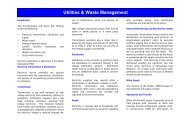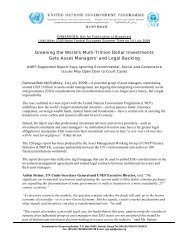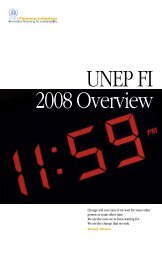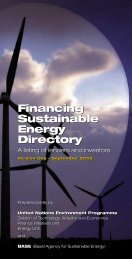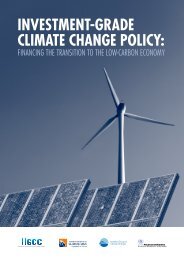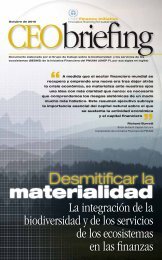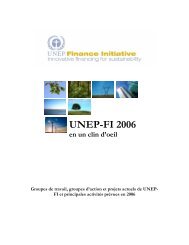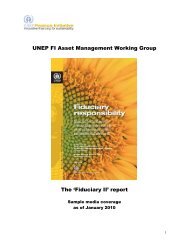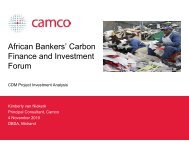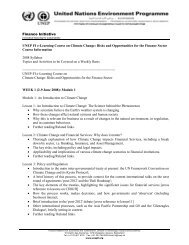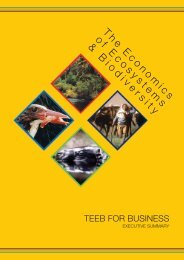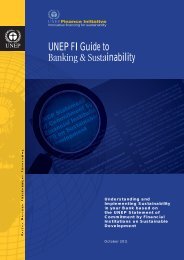Carbon 2009 Emission trading coming home - UNEP Finance Initiative
Carbon 2009 Emission trading coming home - UNEP Finance Initiative
Carbon 2009 Emission trading coming home - UNEP Finance Initiative
You also want an ePaper? Increase the reach of your titles
YUMPU automatically turns print PDFs into web optimized ePapers that Google loves.
<strong>Carbon</strong> <strong>2009</strong><br />
Figure 4.13: EUA price forecasts, 2010 and 2020<br />
Expectations for EUA prices in 2010 (left) 2020 (right). N=968 (<strong>2009</strong>).<br />
40%<br />
35%<br />
2007<br />
2008<br />
<strong>2009</strong><br />
35%<br />
30%<br />
2007<br />
2008<br />
<strong>2009</strong><br />
30%<br />
25%<br />
25%<br />
20%<br />
20%<br />
15%<br />
15%<br />
10%<br />
10%<br />
5%<br />
5%<br />
0%<br />
100<br />
0%<br />
100<br />
Source: Point <strong>Carbon</strong><br />
expectations on the EUA price<br />
dynamics, influenced by a strict<br />
phase 3. Respondents seem<br />
to expect that the fundamental<br />
supply/demand balance in the<br />
long term will push prices up<br />
in the EU ETS. It is somewhat<br />
surprising that the long term<br />
expectations on the global<br />
CO 2 price is more influenced<br />
by the current circumstances<br />
– economic crisis and drop in<br />
EUA price – than the long-term<br />
expectations for EUAs.<br />
Long-term EUA<br />
price expectations<br />
almost unchanged<br />
The stability of the long-term<br />
price expectations for the EUA<br />
indicates that the incentive to<br />
reduce emissions through long<br />
term investments is weighing<br />
quite heavily in the EU ETS and<br />
that the final decision on EU’s<br />
energy and climate package was<br />
close to the original proposal<br />
by the Commission in January<br />
2008.<br />
The global economic slowdown<br />
is doubtless casting a shadow<br />
over the carbon market as well<br />
-- be that in the areas of the EU<br />
ETS, Kyoto flexible mechanisms<br />
or global climate negotiations.<br />
At the same time, the results of<br />
our <strong>2009</strong> survey, as presented<br />
in this report, demonstrate that<br />
participants in the world’s carbon<br />
markets are confident in the longterm<br />
future of emissions <strong>trading</strong><br />
as an instrument to address the<br />
global climate crisis.<br />
While lower carbon prices are<br />
expected in the near term, and<br />
emissions as well as project<br />
investments in some segments<br />
are down, respondents expect<br />
the market to get back on its feet<br />
in the not-too-distant future.<br />
The Dec-10 EUA price and the<br />
Copenhagen COP may not be<br />
expected to match previous<br />
expectations, but faith in carbon<br />
prices for 2020 is unshaken.<br />
Weak near-term<br />
outlook; optimism<br />
for US and longer term<br />
Just as importantly, our survey<br />
shows that emissions <strong>trading</strong><br />
is finally <strong>coming</strong> <strong>home</strong> to the<br />
US, where it was invented. On<br />
the ground, RGGI is already<br />
showing strong growth, while<br />
our respondents expect both<br />
cap-and-trade and international<br />
re-engagement from the<br />
Obama administration. Thus,<br />
developments in the US constitute<br />
the principal bright spot for the<br />
carbon market in <strong>2009</strong>.<br />
40<br />
All rights reserved © <strong>2009</strong> Point <strong>Carbon</strong>



